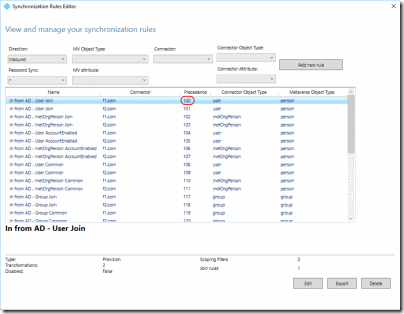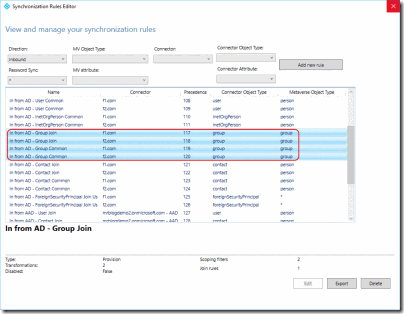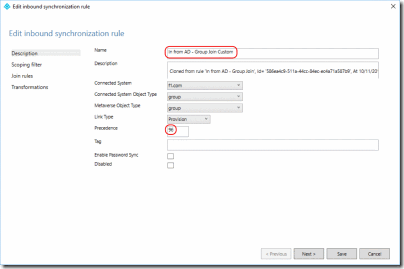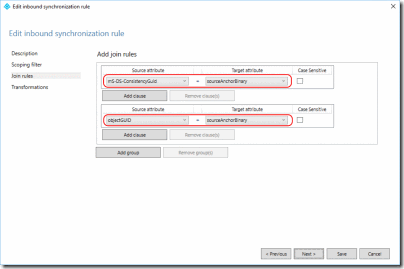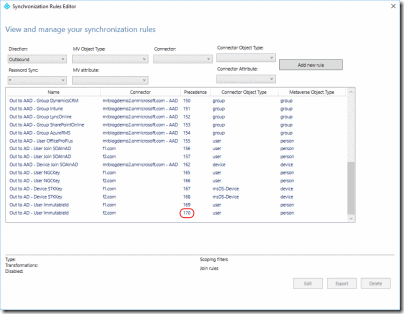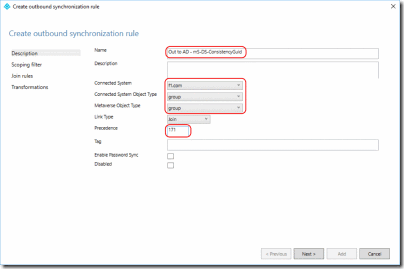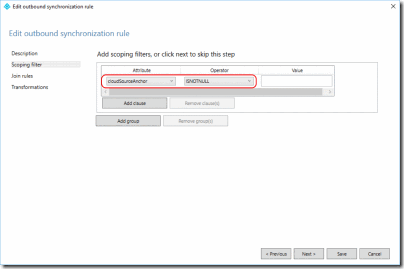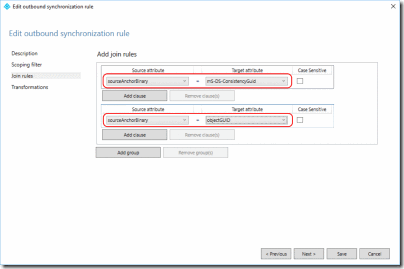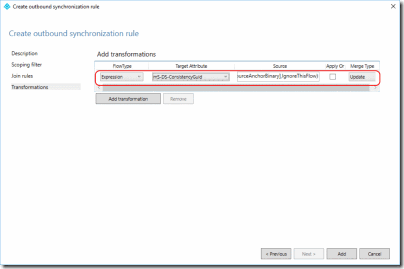Choosing a sourceAnchor for Groups in Multi-Forest Sync with AAD Connect
Introduction
Earlier this year I authored a post discussing choices for sourceAnchor in Multi-Forest Sync with AAD Connect. Following that series, the Azure Active Directory Product Group included sync rules that use mS-DS-ConsistencyGuid as the sourceAnchor for user objects. This was great because it all works out of the box and as an added bonus, there's an action that migrates you from objectGUID to mS-DS-ConsistencyGuid built into the AAD Connect wizard.
Recently, I was working with a customer who was migrating between Forests. These latest changes work terrifically well for user objects but on the current build of AAD Connect (1.1.614.0), the sync rules for Groups do not use mS-DS-ConsistencyGuid. This means, that for groups, you're right back at square one (refer to the earlier series Introduction for background information).
In this post, I'll walk through the setup for custom sync rules so that groups migrate cleanly between Forests and continue to sync with Azure Active Directory without duplication.
Preparation
Pause the sync service by opening a PowerShell prompt and executing
Set-ADSyncScheduler -SchedulerSuspended $true
Open "C:\Program Files\Microsoft Azure AD Sync\UIShell\SyncRulesEditor.exe"
Observe the lowest precedence built-in inbound sync rule (100 in this example) –
Observe the built-in inbound sync rules for Groups, two of each type for each Forest (4 in this example) –
You’ll need to duplicate each of these rules and modify the properties. You’ll set the precedence of the duplicated rules to be lower than the lowest value observed (100 in this example)
Creating Custom Join Rules for Groups
Select the first In from AD -Group Join rule and click Edit
Click Yes at the Edit Reserved Rule Confirmation
Change Description to something like In from AD – Group Join Custom, the Precedence to 4 less than the number observed earlier (96 in this example) and click Next twice –
On the Join Rules page, change the Source attribute to mS-DS-ConsistencyGuid
Click Add group and in the new group, set Source attribute to objectGUID and Target attribute to sourceAnchorBinary
Click Next –
Click Save
Click Yes at the Expression Warning
Repeat for additional In from AD -Group Join rules, this time setting the precedence to one more than last time (97 in this example)
Creating Custom Common Rules for Groups
Select the first In from AD - Group Common rule and click Edit
Click Yes at the Edit Reserved Rule Confirmation
Change Description to something like In from AD – Group Common Custom, the Precedence to one more than the last rule (98 in this example) and click Next three times –
On the Transformations page,
Change sourceAnchor from
ConvertToBase64([objectGUID])
To
IIF(IsPresent([mS-DS-ConsistencyGuid]),ConvertToBase64([mS-DS-ConsistencyGuid]),ConvertToBase64([objectGUID]))
Change sourceAnchorBinary from Direct
[objectGUID]
To an Expression
IIF(IsPresent([mS-DS-ConsistencyGuid]),[mS-DS-ConsistencyGuid],[objectGUID])
Click Save
Repeat for additional In from AD -Group Common rules, this time setting the precedence to one more than last time (99 in this example)
Create Rules to Write mS-DS-ConsistencyGuid back to AD On-Premises
Change rule editor to show outbound rules and take note of the highest precedence rule (170 in this example) –
Click Add new rule
On the Description page, set the Name to Out to AD - mS-DS-ConsistencyGuid
On the Description page, set Connected System to the <Forest you're currently configuring the rule for>
On the Description page, set Connected System Object Type to group
On the Description page, set Metaverse Object Type to group
On the Description page, set the Precedence to a value higher than the precedence noted above (171 in this example) –
Click Next
On the Scoping filter page, click Add group and then Add clause and set the filter to cloudSourceAnchor ISNOTNULL –
Click Next
On the Join rules page, click Add group
Set the Source attribute to sourceAnchorBinary and the Target attribute to mS-DS-ConsistencyGuid
Click Add group again
In the second group, set Source attribute to sourceAnchorBinary and Target attribute to objectGUID –
Click Next
On the Transformations page, click Add transformation. Set the Flow type to Expression, the Target attribute to mS-DS-ConsistencyGuid and the Expression to
IIF(IsPresent([sourceAnchorBinary]),[sourceAnchorBinary],IgnoreThisFlow)
Click Add
Back at the outbound rules editor, click Add Rule and repeat for each additional Forest, setting the precedence to the next number (172 in this example)
Re-establish Sync
Resume the sync service by opening a PowerShell prompt and executing
Set-ADSyncScheduler -SchedulerSuspended $false
Trigger a full sync by executing
Start-ADSyncSyncCycle -PolicyType Initial
Conclusion
This blog post steps through the configuration of sync rules in AAD Connect that use mS-DS-ConsistencyGuid as the sourceAnchor for groups when they are synchronised from on-premises Forests to an Azure Active Directory tenant.
This approach, aligns with the built-in sync rules used for user objects.
